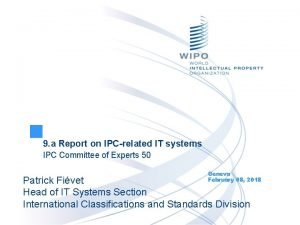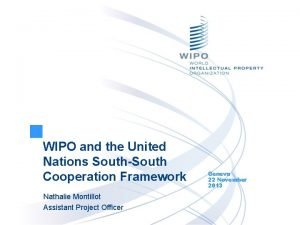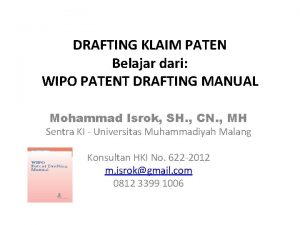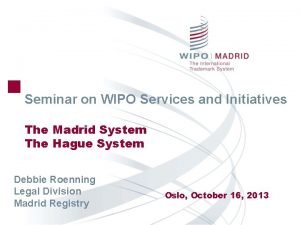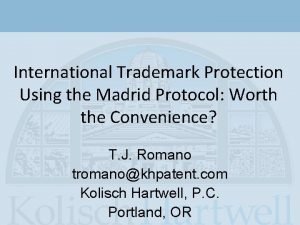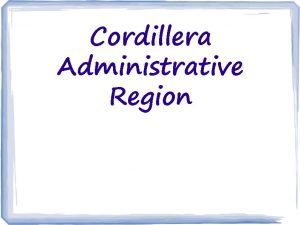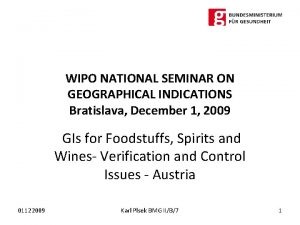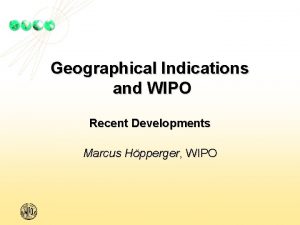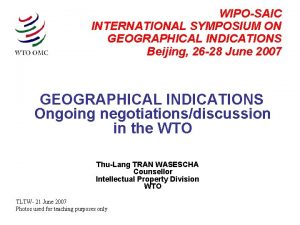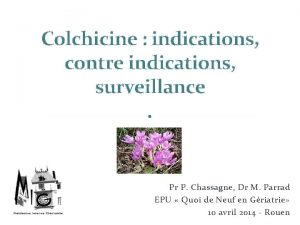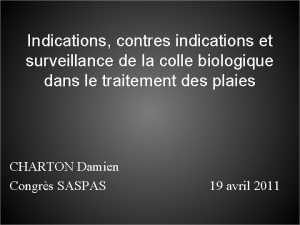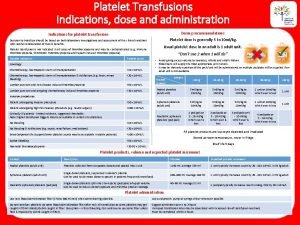WIPO Worldwide GI Symposium Geographical Indications in the














- Slides: 14

WIPO Worldwide GI Symposium Geographical Indications in the WTO Yangzhou, China – 29 -30 June 2017 Wolf MEIER-EWERT World Trade Organization Wolf. Meier-Ewert@wto. org

The 1995 compromise in TRIPS: Two levels of protection for GIs Basic level of protection (Art. 22) against use of a GI l l that misleads the public as to the geographical origin of the good; or that constitutes an act of unfair competition (Art. 10 bis Paris Convention) Additional protection (Art. 23) for GIs for wines and spirits against use on wines and spirits not coming from that origin l l l even where the true origin is indicated, even when used in translation, and even where accompanied by expressions like “kind”, “type” or “style”. 2

The 1995 compromise in TRIPS: Exceptions, and negotiation mandates Exceptions regarding: l l l Generic terms (“customary terms”) (Art. 24. 6) Prior trademark rights (Article 24. 5) Grand-fathering other prior use (Article 24. 4) Personal names (Article 24. 8) GIs not protected or used in their country of origin (Article 24. 9) Negotiations: l l Multilateral Register for wine and spirit GIs (Art. 23. 4) Not deny negotiations to increase protection of individual GIs (Art. 24. 1) 3

Dispute Settlement Case DS 174/290 EC – Protection of Trademarks and Geographical lndications for Agricultural Products and Foodstuffs Complaints: l by the US (WT/DS 174/20) and Australia (WT/DS 290/18) l against the EU Regulation 2081/92 on GIs (foodstuffs) l Panel Report adopted 20 April 2005 (WT/DS 174/R and WT/DS 290/R). No Appeal. l Result: l l EU‘s treatment of relationship between GIs and TMs is not in violation of TRIPS (limited co-existence of TMs and GIs), l but the system discriminates against non-EU GIs and thus violates the national treatment obligation under TRIPS EC amended its Regulation 2081/92. New Regulation 510/2006 entered into force in March 2006. 4

The TRIPS GI regime l l l accommodates different manners of implementation (trademark system / sui generis system / unfair competition) does not require registration as a constitutive element accommodates both l limited coexistence between earlier TMs and GIs (e. g. EU) strict first-in-time first-in-right approach (e. g. US) covered by the WTO Dispute Settlement System 5

Negotiations since 1995 Multilateral Register for GIs for wines and spirits Negotiating Positions: l Main differences: legal effect and participation l Two basic approaches: l l Commitment to consult a data base of registered GIs; legal effects under the domestic law; voluntary participation A registration to have certain legal effects in all Members Middle ground proposed Hong Kong, China: certain presumptions; voluntary participation Draft composite text in 2011 6

Multilateral Register Negotiations: The proposals on the table in 2011 - TN/IP/W/10/Rev. 4 by the Joint Proposal Group (Argentina, Australia, Canada, Chile, Costa Rica, Dominican Republic, Ecuador, El Salvador, Guatemala, Honduras, Israel, Japan, Korea, Mexico, New Zealand, Nicaragua, Paraguay, South Africa, Chinese Taipei and the United States) (March 2011) (Voluntary participation, commitment to consult the register, legal effects only under national law) – TN/IP/W/8 by Hong Kong, China (April 2003) (Voluntary participation, certain rebuttable legal presumptions) - TN/C/W/52 (para. 1 -3 and 9) by the “Modalities Group” (Albania, Brazil, China, Colombia, Croatia, the European Communities, Georgia, Iceland, India, Indonesia, the Kyrgyz Republic, Liechtenstein, Moldova, the Former Yugoslav Republic of Macedonia, Pakistan, Peru, Sri Lanka, Switzerland, Thailand, Turkey, the ACP Group and the African Group) (July 2008) (Mandatory participation, register information is prima facie evidence for meeting the GI definition, assertions of genericism have to be substantiated) 7

State of Play TRIPS represents the current consensus on minimum protection standards for GIs and Trademarks l l l and thus defines how much GIs can be privileged vis-à -vis Trademarks No multilateral consensus on what kind of GI register could bridge the differences in national approaches l l currently no progress in WTO negotiations WIPO Lisbon revision remains plurilateral 8

Momentum in bilateral agreements The multilateral divide is also reflected in different approaches to bilateral agreements on GIs: l e. g. EU bilateral treaties focus on registration systems and protection of lists of GIs l EU-China „ 10 -plus-10 project“ l e. g. US bilateral initiatives focus on safeguarding trademark rights and maintaining generic terms l US-China Joint Commission on Commerce and Trade: l l generic terms are not eligible for protection relationship GIs-TMs handled in accordance with TRIPS Legal means for interested 3 rd parties to object to and cancel GIs Adopt disclaimer practice for generic components of GIs 9

Geographical Indication provisions in the Trans-Pacific Partnership Agreement Detailed provisions on IPRs, including geographical indications, with respect to, inter alia: l administrative procedures for filing, recognition and protection of GIs: l interested parties must have opportunity to object to protection l l of GIs applied for under national procedures, and for GIs recognized through bilateral treaties grounds for refusal must include genericism or confusion with prior trademarks (incl. guidelines for determining genericism) Multi-component terms 10

WTO - Trade Policy Reviews (TPRs) Detailed questions on geographical indications protection in recent TPRs: May 2017 April 2017 March 2017 Dec 2016 Nov 2016 Oct 2016 Sep 2016 July 2016 Switzerland Liechtenstein Mexico Japan United States Guatemala Sri Lanka Korea, Republic of Russian Federation Singapore China Tunisia 11

Questions in Trade Policy Reviews Detailed scrutiny of national systems: l relationship between trademarks and GIs l how are third-party rights recognized during the registration process? l is coexistence possible? l what procedures for opposition/cancellation regarding GIs protected and introduced under bilateral treaties? l What are the criteria for establishing genericism? l Discussion on new forms of protection 12

Conclusion Origin branding of products and services in trade has increasingly been recognised as valuable across the globe in the last two decades …. … but considerable controversy remains over which legal means should be used to implement such origin branding, and how best to create a truly global framework for GI protection. 13

www. wto. org For more information: wolf. meier-ewert@wto. org Tel. : +41 22 739 63 44 14
 Wipo worldwide academy
Wipo worldwide academy Global design database
Global design database Wipo
Wipo Wipo distance learning
Wipo distance learning Wipo ipccat
Wipo ipccat Global brand database
Global brand database Buenos aires plan of action
Buenos aires plan of action Wipo academy courses
Wipo academy courses Wipo patent drafting manual
Wipo patent drafting manual Madrid goods and services manager
Madrid goods and services manager Global brand database
Global brand database Romarin wipo
Romarin wipo Wipo gbd
Wipo gbd Hudhud ni aliguyon summary
Hudhud ni aliguyon summary Geographical features of bangladesh
Geographical features of bangladesh




